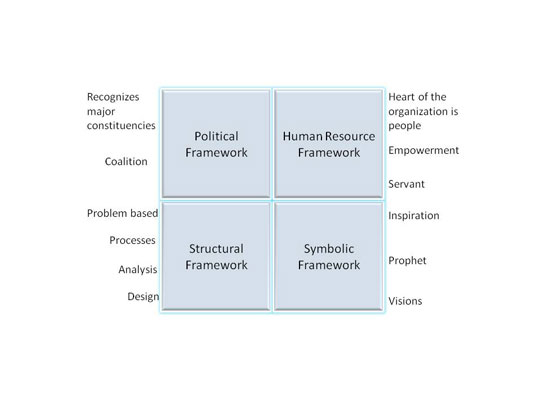Leadership Models
Leadership models help us to understand what makes leaders act the way they do. The ideal is not to lock yourself in to a type of behavior discussed in the model, but to realize that every situation calls for a different approach or behavior to be taken. Two models will be discussed, the Four Framework Approach and the Managerial Grid.Four Framework Approach
In the Four Framework Approach, Bolman and Deal (1991) suggest that leaders display leadership behaviors in one of four types of frameworks: Structural, Human Resource, Political, or Symbolic.
Structural Framework
In an effective leadership situation, the leader is a social architect whose leadership style is analysis and design. While in an ineffective leadership situation, the leader is a petty tyrant whose leadership style is details. Structural Leaders focus on structure, strategy, environment, implementation, experimentation, and adaptation.Human Resource Framework
In an effective leadership situation, the leader is a catalyst and servant whose leadership style is support, advocating, and empowerment. while in an ineffective leadership situation, the leader is a pushover, whose leadership style is abdication and fraud. Human Resource Leaders believe in people and communicate that belief; they are visible and accessible; they empower, increase participation, support, share information, and move decision making down into the organization.Political Framework
In an effective leadership situation, the leader is an advocate, whose leadership style is coalition and building. While in an ineffective leadership situation, the leader is a hustler, whose leadership style is manipulation. Political leaders clarify what they want and what they can get; they assess the distribution of power and interests; they build linkages to other stakeholders, use persuasion first, then use negotiation and coercion only if necessary.Symbolic Framework
In an effective leadership situation, the leader is a prophet, whose leadership style is inspiration. While in an ineffective leadership situation, the leader is a fanatic or fool, whose leadership style is smoke and mirrors. Symbolic leaders view organizations as a stage or theater to play certain roles and give impressions; these leaders use symbols to capture attention; they try to frame experience by providing plausible interpretations of experiences; they discover and communicate a vision.For an activity, see Bolman and Deal's Four Framework Approach.
Managerial Grid
The Blake and Mouton Managerial Grid, also known as the Leadership Grid (1985) uses two axis:- "Concern for people" is plotted using the vertical axis
- "Concern for task or results" is plotted along the horizontal axis.

- Authoritarian — strong on tasks, weak on people skills
- Country Club — strong on people skills, weak on tasks
- Impoverished — weak on tasks, weak on people skills
- Team Leader — strong on tasks, strong on people skills
Authoritarian Leader (high task, low relationship)
Leaders who get this rating are very much task oriented and are hard on their workers (autocratic). There is little or no allowance for cooperation or collaboration. Heavily task oriented people display these characteristics: they are very strong on schedules; they expect people to do what they are told without question or debate; when something goes wrong they tend to focus on who is to blame rather than concentrate on exactly what is wrong and how to prevent it; they are intolerant of what they see as dissent (it may just be someone's creativity), so it is difficult for their subordinates to contribute or develop.Team Leader (high task, high relationship)
These leaders lead by positive example and endeavor to foster a team environment in that all team members can reach their highest potential, both as team members and as people. They encourage the team to reach team goals as effectively as possible, while also working tirelessly to strengthen the bonds among the various members. They normally form and lead some of the most productive teams.Country Club Leader (low task, high relationship)
These leaders predominantly use reward power to maintain discipline and to encourage the team to accomplish its goals. Conversely, they are almost incapable of employing the more punitive coercive and legitimate powers. This inability results from fear that using such powers could jeopardize relationships with the other team members.Impoverished Leader (low task, low relationship)
These leaders use a “delegate and disappear” management style. Since they are not committed to either task accomplishment or maintenance; they essentially allow their team to do whatever it wishes and prefer to detach themselves from the team process by allowing the team to suffer from a series of power struggles.The most desirable place for a leader to be along the two axes at most times would be a 9 on task and a 9 on people — the Team Leader. However, do not entirely dismiss the other three. Certain situations might call for one of the other three to be used at times. For example, by playing the Impoverished Leader, you allow your team to gain self-reliance. Be an Authoritarian Leader to instill a sense of discipline in an unmotivated worker. By carefully studying the situation and the forces affecting it, you will know at what points along the axes you need to be in order to achieve the desired result.
For an activity, see The Leadership Matrix
source



